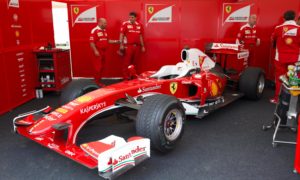Understeer and Oversteer
The forces exerted on the wheels by the weight of the vehicle are not distributed evenly. This means the slip angle for each tyre is different. The ratio between the slip angles on each tyre determine the way the car corners. If the ratio of front to rear slip angles is greater than 1:1 (ie the front tyres do not have as much grip as the rears), the car will tend to understeer. A ratio of less than 1:1 (ie the front tyres have more grip than the rears) will produce oversteer.
Understeer causes the car to go straighter than the trajectory that the driver is trying to take. This is sometimes known as pushing, plowing, or ‘refusing to turn in’. However, the car will be fairly stable as it is not wanting to spin. Understeer can appear under heavy acceleration and through heavy braking. If the brake balance is too heavy at the front (the front brakes are stronger than the rear), the car may understeer because the front wheels lock and lose effective steering. To counter understeer, more rear wing can be added to create more downforce at the back of the car, and the rear suspension softened.
Oversteer is when the rear wheels of a car do not track behind the front wheels. Instead, they tend to slide out towards the outside of the turn. This can easily cause a car to spin. In a race car, particularly open-wheeled cars, oversteering in high speed turns is caused mainly by aerodynamic configuration; A heavy aerodynamic load on the front of the car relative to the rear causes it to oversteer. In low turn speeds, oversteer can be reduced by traction control systems. To overcome oversteer, more front downforce is needed. This is usually achieved by changing the suspension settings.
Although understeer and oversteer can both cause a loss of control, many cars are designed to lean towards understeer as it is generally believed that it is easier to recover from understeer than it is from oversteer.
A car which neither understeers nor oversteers at it’s limit is known as a car with ‘neutral handling’. Race cars are often setup to slightly understeer as accelerating hard after the apex of a corner allows the car to get the maximum amount of speed down the following straight. The car that starts the acceleration soonest will usually have the biggest advantage, so slight understeer will help the driver to maximise the traction on the tyres and help them get a good exit out of the corner. An oversteering car also has a tendancy to be quite ‘twitchy’ meaning the driver is more likely to lose control during the course of a race.
Driving style is a massive factor in whether to setup a car to slightly understeer, or slightly oversteer. Some drivers prefer oversteer as they like to have a car which is more willing to turn into corners. This is why drivers in the same team will often run with different balance settings and also why these settings may be changed during the course of a race.








